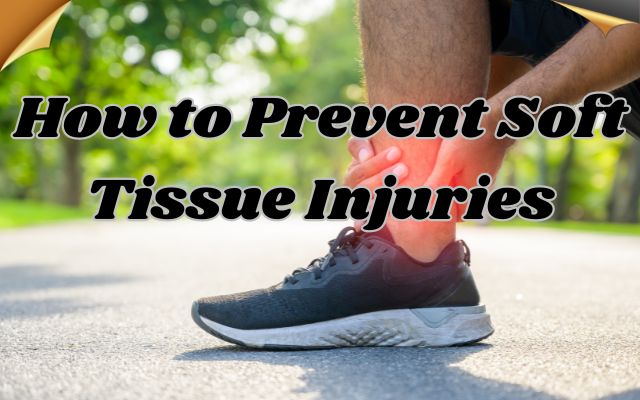How to Prevent Soft Tissue Injuries

Soft tissue injuries, including strains, sprains, and contusions, can be painful and disruptive. They often result from accidents, overuse, or incorrect physical techniques. However, the good news is that many soft tissue injuries can be prevented with the right knowledge and precautions. In this comprehensive guide, we’ll explore various strategies to prevent soft tissue injuries, helping you stay active, healthy, and injury-free.
Understanding Soft Tissue Injuries
A. What Are Soft Tissue Injuries?
Soft tissue injuries involve damage to muscles, tendons, or ligaments. They can cause pain, swelling, and limited mobility. These injuries can affect people of all ages, whether they’re active athletes or lead a more sedentary lifestyle.
B. Common Types of Soft Tissue Injuries
- Strains: Strains occur when a muscle or tendon is stretched or torn. They are often the result of overexertion or sudden movements.
- Sprains: Sprains involve the stretching or tearing of a ligament, which connects bones to each other. These typically happen during physical activities that require sudden changes in direction.
- Contusions: Contusions are bruises caused by direct blows to the muscle. These are common in contact sports or accidents.
C. Causes and Risk Factors
Various factors contribute to soft tissue injuries:
- Overexertion: Pushing the body beyond its limits, especially during physical activities, increases the risk.
- Inadequate Warm-Up: Failing to warm up properly before exercise can strain cold muscles.
- Poor Technique: Incorrect movements, posture, or lifting techniques can lead to injuries.
- Inadequate Rest: Not allowing the body enough time to recover between activities can result in overuse injuries.
Preventive Measures Before Physical Activity
A. Warm-Up and Stretching
Before any physical activity, whether it’s a workout or a sports game, warming up is essential. A good warm-up increases blood flow, prepares muscles and joints for action, and reduces the risk of injury. Include dynamic stretching exercises like leg swings, arm circles, and hip rotations in your warm-up routine.
Static stretching, which involves holding a stretch for an extended period, is best done after your activity when your muscles are warm. Focus on the major muscle groups you’ll be using during the activity.
B. Proper Footwear
Choosing the right footwear is crucial for preventing injuries, especially if you’re into running, walking, or any sport that involves significant foot movement. Proper shoes should offer support, cushioning, and stability.
Before purchasing new athletic shoes, consider your foot type (pronated, supinated, or neutral) and the specific demands of your chosen activity. Make sure the shoes fit well and provide adequate arch support.
C. Understanding Your Limits
Know your body’s limits. Don’t push yourself too hard too quickly. Start with activities suitable for your current fitness level and gradually increase intensity and duration.
Listen to your body’s signals. If you experience pain or discomfort, it’s essential to stop and assess the situation rather than pushing through it. Pain is often an early warning sign of potential injury.
D. Adequate Hydration and Nutrition
Proper hydration and nutrition are often overlooked but are critical in injury prevention. Dehydration can lead to muscle cramps, reduced energy, and impaired performance. Ensure you’re well-hydrated before and during physical activities.
A balanced diet with sufficient nutrients, including carbohydrates, proteins, fats, vitamins, and minerals, is vital for overall health and injury prevention. Consult with a healthcare professional or nutritionist if you have specific dietary concerns.
Safe Practices During Physical Activities
A. Correct Techniques
Learning and maintaining proper technique for your chosen activity can significantly reduce the risk of soft tissue injuries. If you’re engaging in a new sport or exercise, consider taking lessons from a qualified instructor. They can teach you the right form and help you avoid bad habits that may lead to injury.
B. Appropriate Gear and Equipment
Ensure that you have the right gear and equipment for your activity. Protective gear such as helmets, knee pads, or wrist guards can be crucial in contact sports or high-risk activities. Properly fitted equipment can make a substantial difference in injury prevention.
C. Gradual Progression
When increasing the intensity or duration of an activity, do it gradually. Sudden changes in activity levels can stress your soft tissues and increase the risk of injury. If you’re starting a new exercise program, consider a structured plan that includes progressive increases in intensity and duration.
D. Cross-Training
Variety is key to injury prevention. Engaging in a variety of activities reduces the risk of overuse injuries. Cross-training, or participating in different types of exercise, can help balance and strengthen different muscle groups while giving others time to recover.
Post-Activity Care
A. Cooling Down
After a workout or physical activity, don’t skip the cooldown. Gentle stretching can help reduce muscle tension and soreness. Gradually decrease your activity’s intensity before coming to a complete stop.
B. Rest and Recovery
Rest is essential for preventing overuse injuries. Adequate sleep and rest days between intense activities allow your soft tissues to repair and adapt to the demands of exercise. Pay attention to your body, and don’t ignore signs of fatigue or pain.
C. Self-Care Techniques
Consider incorporating self-care techniques like massage, foam rolling, or self-myofascial release into your routine. These can help reduce muscle tension and prevent stiffness that can lead to injury.
Preventing Specific Soft Tissue Injuries
A. Preventing Sprains
- Ankle Sprains: Strengthen the muscles around the ankle through exercises, and use proper footwear that supports the ankles.
- Wrist Sprains: Wear wrist guards during activities that put stress on the wrists, like skating or snowboarding.
B. Preventing Strains
- Hamstring Strains: Stretch and strengthen the hamstrings and other leg muscles, and warm up before activities that involve running or jumping.
- Back Strains: Maintain proper posture, especially when lifting heavy objects, and strengthen core muscles to support the lower back.
C. Preventing Contusions
- Bruises: Protective gear, like helmets and padding, can help minimize the risk of contusions. For accidental bumps and falls, apply ice to reduce swelling.
D. Preventing Tendonitis
- Tendonitis: Gradual progression in activity, proper technique, and adequate rest can help prevent overuse injuries that lead to tendonitis.
The Role of Strength and Flexibility Training
A. Building Muscle Strength
- Strength training can stabilize and protect soft tissues. Include exercises that target major muscle groups to prevent imbalances.
- Consult with a fitness professional or physical therapist to design a well-rounded strength training program.
B. Improving Flexibility
- Maintaining good flexibility helps prevent strains and sprains. Incorporate regular stretching exercises, especially after a warm-up or activity.
- Exercises like yoga and pilates are great ways to increase your general flexibility.
Listening to Your Body
A. Recognizing Warning Signs
- Pay attention to any signs of discomfort, pain, or changes in mobility. These are early signals that something may be wrong.
- Don’t ignore pain. Rest, seek medical advice, and consider modifying your activities as needed.
B. Avoiding Overexertion
- One major cause of soft tissue injuries is overexertion. Pushing beyond your limits can lead to strains and sprains. It’s important to find a balance between challenging yourself and avoiding excessive strain.
Aging and Soft Tissue Injuries
Special Considerations for Seniors
- As we age, soft tissues become less flexible. Special attention to flexibility and strength training can help older individuals reduce the risk of injury.
- Consider working with a physical therapist who can design a program tailored to your needs and limitations.
Preventing Recurring Injuries
Rehabilitation and Physical Therapy
- If you’ve previously suffered a soft tissue injury, especially a recurring one, physical therapy can be invaluable in rehabilitation and preventing future occurrences.
- A physical therapist can guide you through exercises to restore strength and flexibility while teaching proper body mechanics.
Mindful Return to Activity
- When recovering from an injury, take your time and ensure you’re fully healed before resuming activities.
- Discuss your plans with a healthcare professional, who can provide guidelines for a safe return to your regular routine.
FAQ on Preventing Soft Tissue Injuries
What are the differences between soft tissue injuries and other sorts of injuries?
Soft tissue injuries involve damage to muscles, tendons, or ligaments, while other injuries may affect bones or organs. Soft tissue injuries often result from overuse, accidents, or improper techniques during physical activities.
Are soft tissue injuries common, and who is at risk?
Soft tissue injuries are relatively common and can affect people of all ages and activity levels. Athletes, particularly those in contact sports, and individuals who perform repetitive physical tasks are at higher risk.
How can I prevent soft tissue injuries before physical activity?
Prevention begins with proper warm-up and stretching, wearing appropriate footwear, understanding your physical limits, and maintaining adequate hydration and nutrition.
What is the significance of proper footwear in injury prevention?
Proper footwear provides support, cushioning, and stability, which can reduce the risk of injury, especially for activities involving a lot of foot movement. Choosing shoes that match your foot type and the demands of your activity is crucial.
How can I recognize the signs of overexertion and avoid pushing my body too hard?
Recognizing signs of overexertion, such as pain, discomfort, or excessive fatigue, is crucial. Avoid pushing your body beyond its limits, start at your current fitness level, and gradually increase intensity and duration.
What role does cross-training play in injury prevention?
Cross-training, or engaging in a variety of activities, helps balance and strengthen different muscle groups while allowing others to recover. The likelihood of overuse injuries is lower with this kind.
What should I do after physical activity to prevent injuries?
Cooling down through gentle stretching, ensuring adequate rest and recovery, and using self-care techniques like massage or foam rolling can help reduce the risk of soft tissue injuries.
How can I prevent specific soft tissue injuries like sprains, strains, and contusions?
Preventing specific injuries involves strengthening the relevant muscle groups, using protective gear, and applying proper techniques to minimize the risk of injury.
How can strength training and flexibility exercises help prevent soft tissue injuries?
Strength training stabilizes and protects soft tissues, while flexibility exercises reduce the risk of strains and sprains. A well-rounded program, designed with professional guidance, is essential.
What are the early warning signs of potential soft tissue injuries, and when should I seek medical advice?
Early warning signs include discomfort, pain, or changes in mobility. If you experience these symptoms, it’s essential to stop and assess the situation, and if necessary, consult a healthcare professional for advice.
Are soft tissue injuries more common as we age, and what precautions should seniors take?
Soft tissue injuries become more common as we age due to reduced flexibility. Seniors should pay special attention to flexibility and strength training, potentially with the guidance of a physical therapist.
If I’ve had a previous soft tissue injury, how can I prevent it from recurring?
Preventing recurring injuries involves rehabilitation and physical therapy to restore strength and flexibility. It’s crucial to have a well-structured plan for a safe return to regular activities.
Can soft tissue injuries be completely avoided, or is the goal to minimize the risk?
While it’s challenging to completely avoid all soft tissue injuries, the goal is to minimize the risk by following preventive measures and listening to your body. This way, you can lead an active and healthy lifestyle with fewer injuries.
Conclusion and Future Steps
Preventing soft tissue injuries is within your reach. By understanding the types of injuries, knowing the risk factors, and following the preventive measures discussed in this comprehensive guide, you can significantly reduce your chances of experiencing these painful and sometimes debilitating injuries.
Remember to respect your body’s limits, warm up properly, use the right gear, and embrace cross-training and rest. Listen to your body’s signals, and don’t hesitate to seek medical advice when needed. By taking these proactive steps, you can enjoy an active and healthy lifestyle while minimizing the risk of soft tissue injuries. So, go out, stay active, and be kind to your body, and you’ll reap the benefits of a long, injury-free journey towards health and fitness.



